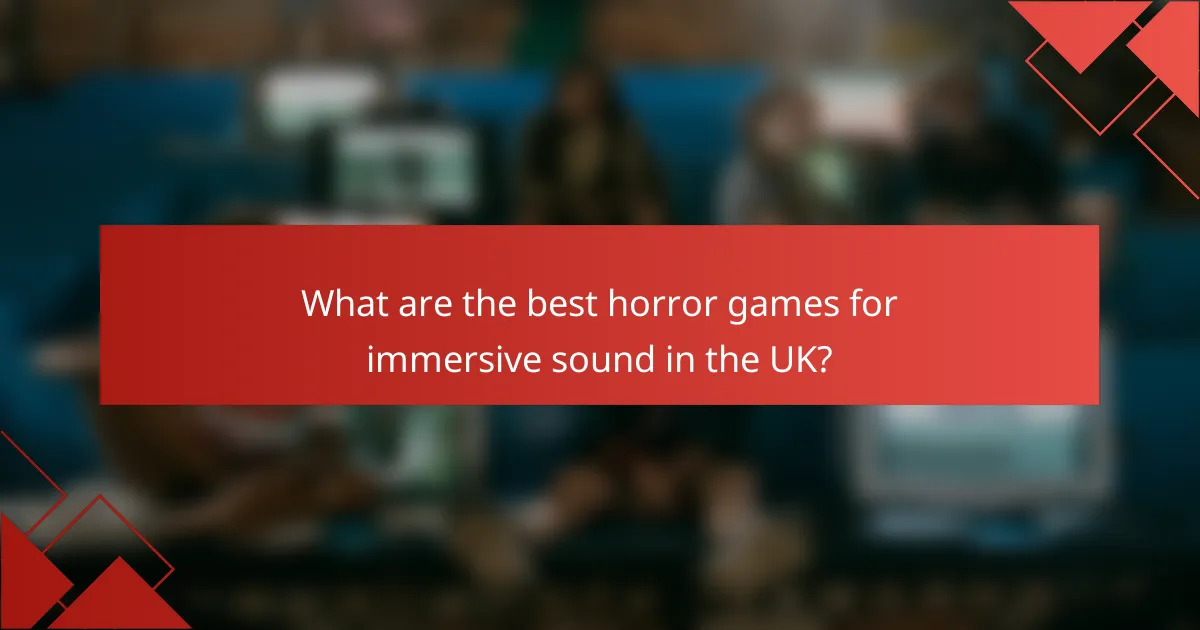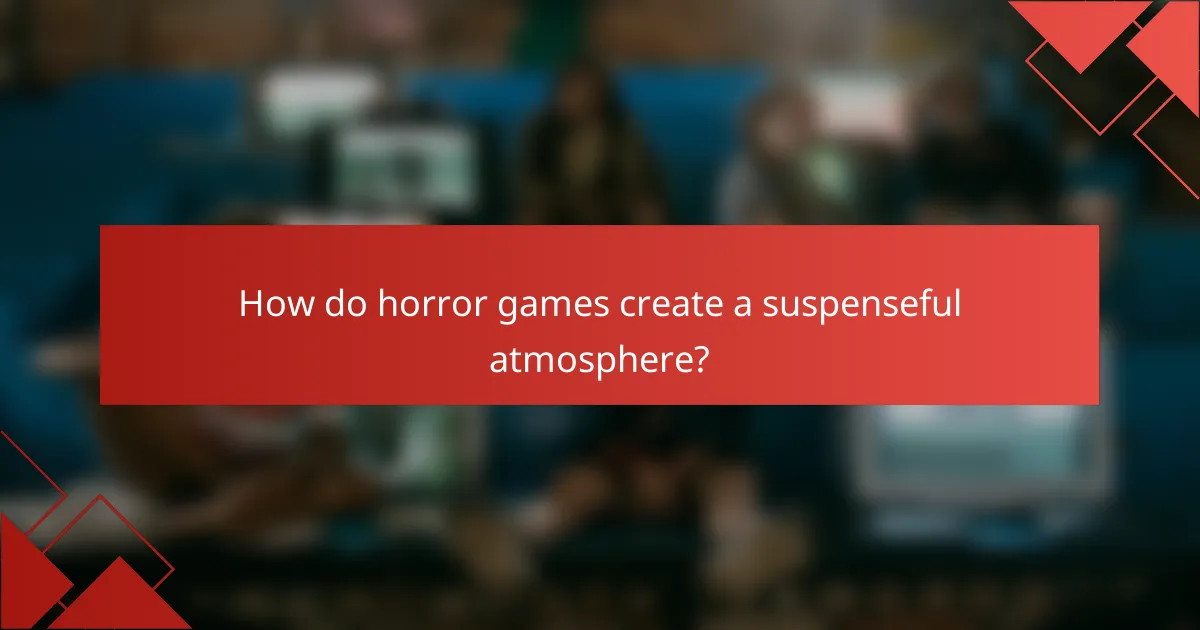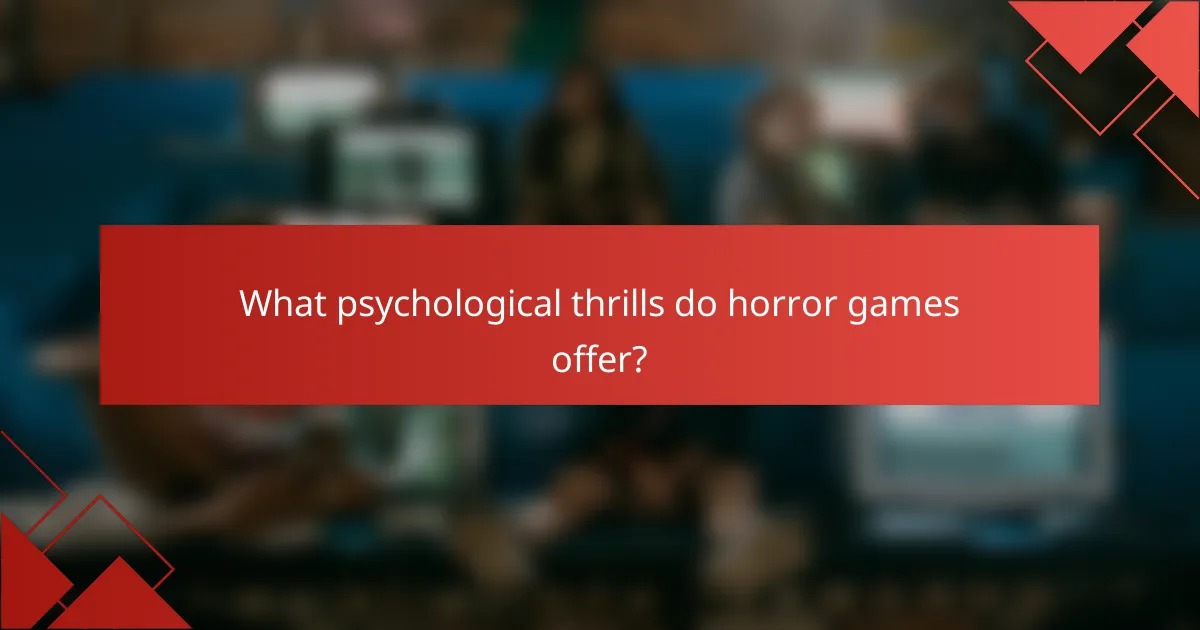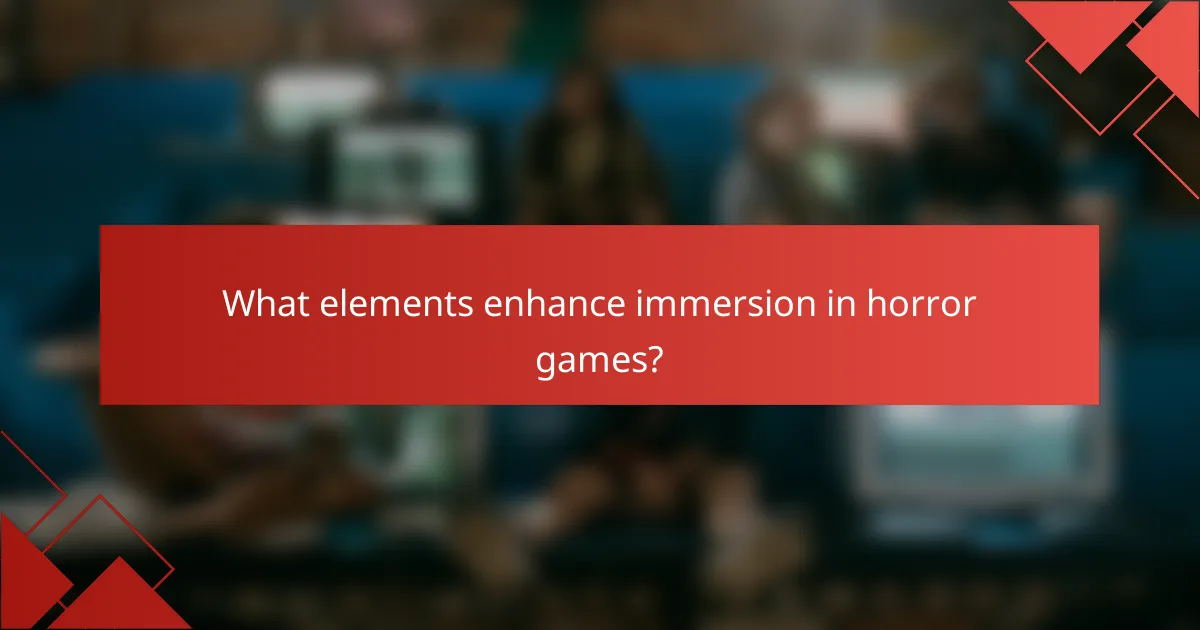Immerse yourself in the chilling world of horror games, where suspenseful atmospheres and psychological thrills await. With meticulously crafted soundscapes and gripping narratives, titles like Resident Evil Village and Silent Hill 2 elevate tension and fear, drawing players into unsettling experiences. Prepare to confront your deepest anxieties as you navigate through environments designed to keep you on edge.

What are the best horror games for immersive sound in the UK?
The best horror games for immersive sound in the UK create a chilling atmosphere through detailed audio design, enhancing psychological thrills and player engagement. Titles like Resident Evil Village, Silent Hill 2, and Dead Space are renowned for their exceptional soundscapes that heighten tension and fear.
Resident Evil Village
Resident Evil Village is celebrated for its atmospheric sound design that pulls players into its eerie world. The game uses 3D audio technology to create a sense of space, allowing players to hear distant sounds that hint at lurking dangers, enhancing the suspense.
Key features include dynamic sound effects that respond to player actions, such as footsteps echoing in different environments. Utilizing high-quality headphones can significantly amplify the immersive experience, making every creak and whisper feel more real.
Silent Hill 2
Silent Hill 2 is a classic horror game known for its haunting soundscapes that evoke deep psychological unease. The use of ambient noise, unsettling music, and character voices creates a pervasive sense of dread that permeates the gameplay.
Players should pay attention to the sound cues that signal danger or reveal story elements. The game’s audio design is integral to its narrative, making it essential to experience it in a quiet environment for maximum impact.
Dead Space
Dead Space excels in creating a terrifying atmosphere through its chilling sound effects and music. The game employs a mix of unsettling ambient sounds and sudden audio cues to keep players on edge, enhancing the horror experience.
Utilizing surround sound systems or quality headphones can greatly enhance the experience, allowing players to pinpoint the source of terrifying sounds. The game’s audio is designed to trigger fear responses, making it vital to remain alert to the auditory clues that indicate threats.

How do horror games create a suspenseful atmosphere?
Horror games create a suspenseful atmosphere through a combination of visual elements, sound design, and narrative techniques that evoke fear and tension. These elements work together to immerse players in an unsettling experience, keeping them on edge and engaged throughout the gameplay.
Lighting and visual design
Lighting plays a crucial role in establishing a suspenseful atmosphere in horror games. Dim lighting, shadows, and flickering lights can create a sense of uncertainty and fear, making players wary of what might be lurking in the dark. For instance, using low-key lighting can enhance the eeriness of a scene, while sudden changes in brightness can startle players.
Visual design also contributes significantly to the overall mood. Distorted imagery, unsettling character designs, and eerie environments can amplify feelings of dread. Incorporating elements like fog or rain can further enhance the atmosphere, making players feel isolated and vulnerable.
Sound design techniques
Sound design is essential in horror games for building tension and creating an immersive experience. Ambient sounds, such as distant whispers or creaking floors, can instill a sense of dread, while sudden loud noises can induce shock. Using silence strategically can also heighten suspense, making players anticipate what might happen next.
Additionally, sound cues can guide players’ emotions and reactions. For example, a heartbeat sound might increase in intensity during a chase scene, mirroring the player’s rising anxiety. Effective sound design not only enhances the atmosphere but also deepens the psychological impact of the game.

What psychological thrills do horror games offer?
Horror games deliver psychological thrills by immersing players in tense, suspenseful environments that evoke fear and anxiety. These experiences often rely on unexpected events and deep narratives to keep players engaged and on edge.
Fear of the unknown
The fear of the unknown is a powerful element in horror games, as it plays on players’ imaginations and uncertainties. When players encounter dark, unexplored areas or ambiguous threats, their minds fill in the gaps, amplifying tension and dread.
Developers often use limited visibility, eerie soundscapes, and unpredictable enemy behavior to enhance this fear. For instance, a game might feature a dimly lit corridor where players hear unsettling noises but cannot see what is lurking nearby, creating a sense of vulnerability.
Character-driven narratives
Character-driven narratives in horror games deepen the psychological impact by allowing players to connect emotionally with the characters. When players invest in a character’s journey, their fear intensifies as they face perilous situations alongside them.
Effective storytelling often includes backstories that reveal personal traumas or moral dilemmas, making players empathize with the characters’ struggles. For example, a character haunted by guilt may face supernatural manifestations of their past, heightening the emotional stakes and suspense.

What elements enhance immersion in horror games?
Immersion in horror games is significantly enhanced by elements like virtual reality integration and dynamic soundscapes. These features create a more engaging and terrifying experience, drawing players deeper into the game world.
Virtual reality integration
Virtual reality (VR) integration amplifies immersion by placing players directly within the horror environment. Using VR headsets, players can experience a 360-degree view, making them feel as though they are truly part of the game.
When designing VR horror experiences, consider factors like motion tracking and user comfort. Poor tracking can lead to disorientation, while excessive movement may cause discomfort. Aim for a balance that keeps players engaged without overwhelming them.
Dynamic soundscapes
Dynamic soundscapes play a crucial role in building suspense and psychological tension in horror games. Surround sound and spatial audio techniques create an auditory environment that reacts to player actions, enhancing the feeling of presence.
To effectively utilize sound, incorporate ambient noises, sudden audio cues, and directional sounds that guide players’ attention. For example, subtle whispers or distant footsteps can heighten anxiety and anticipation. Ensure that sound design complements the visual elements for a cohesive experience.

How to choose a horror game for psychological impact?
To select a horror game that delivers psychological impact, focus on titles known for their suspenseful atmosphere, immersive sound design, and strong narrative elements. Look for games that evoke fear through psychological thrills rather than just jump scares.
Player reviews and ratings
Player reviews and ratings can provide valuable insights into the psychological impact of a horror game. Look for games with high ratings that specifically mention elements like atmosphere and psychological tension. Platforms like Steam or Metacritic often feature user reviews that highlight these aspects.
Pay attention to comments about the game’s ability to create suspense and engage players emotionally. A game with a strong community following may indicate a deeper psychological experience, as players often share their feelings and reactions to the game’s narrative and design.
Game mechanics and design
The mechanics and design of a horror game significantly influence its psychological impact. Games that utilize sound effectively, such as ambient noises or unsettling music, can enhance the feeling of dread and immersion. Look for titles that incorporate these elements into gameplay, making players feel constantly on edge.
Additionally, consider the narrative structure and pacing. Games that build tension gradually, using storytelling techniques like unreliable narrators or complex character development, often create a more profound psychological experience. Examples include titles that allow for player choices that affect the story’s outcome, adding layers of psychological depth.

What are the emerging trends in horror gaming?
Emerging trends in horror gaming focus on enhancing player immersion through innovative technologies and storytelling techniques. Key developments include AI-driven narratives that adapt to player choices and cross-platform experiences that allow gamers to connect across different devices.
AI-driven narratives
AI-driven narratives in horror games create dynamic storylines that respond to player actions, making each playthrough unique. This technology can analyze player behavior and adjust the plot, character interactions, and even the environment to heighten suspense and psychological thrills.
For example, a horror game might change the antagonist’s tactics based on how players react to scares, keeping them on edge. Developers should consider balancing complexity with accessibility, ensuring that players can still follow the story without feeling overwhelmed by choices.
Cross-platform experiences
Cross-platform experiences in horror gaming allow players on different devices to interact within the same game environment. This trend enhances community engagement and enables friends to play together regardless of their chosen platform, whether it’s PC, console, or mobile.
To maximize the benefits of cross-platform play, developers should focus on maintaining consistent performance and user experience across devices. Additionally, they should consider implementing features like shared progress and synchronized updates to keep players connected and invested in the game.


